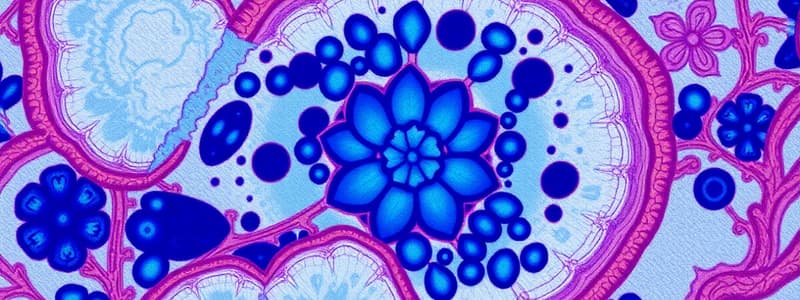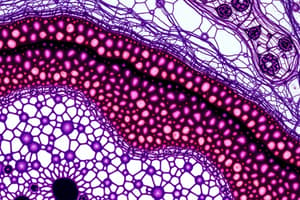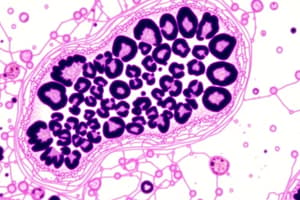Podcast
Questions and Answers
What is the main purpose of freezing tissue rapidly in liquid nitrogen?
What is the main purpose of freezing tissue rapidly in liquid nitrogen?
- To enhance the color of the tissue for clearer observation
- To enable the growth of new cells in the tissue
- To preserve tissue details that may be lost in other techniques (correct)
- To reduce the size of the tissue samples
Which of the following components is NOT considered an organelle?
Which of the following components is NOT considered an organelle?
- Ribosome
- Golgi apparatus
- Cytosol (correct)
- Mitochondria
What thickness do sections typically have when using the freezing technique?
What thickness do sections typically have when using the freezing technique?
- 2 - 5 µm
- 5 - 10 µm (correct)
- 15 - 20 µm
- 10 - 15 µm
Which structure serves as the genetic control center of a eukaryotic cell?
Which structure serves as the genetic control center of a eukaryotic cell?
What defines membranous organelles compared to non-membranous organelles?
What defines membranous organelles compared to non-membranous organelles?
What substance is primarily found in the cytosol of a cell?
What substance is primarily found in the cytosol of a cell?
Which of the following is an example of a non-essential inclusion in a cell?
Which of the following is an example of a non-essential inclusion in a cell?
The outermost cover of the cytoplasm is referred to as which structure?
The outermost cover of the cytoplasm is referred to as which structure?
What is the primary component that makes up cell membranes?
What is the primary component that makes up cell membranes?
What appearance is created by the arrangement of phospholipids in the cell membrane as seen under electron microscopy?
What appearance is created by the arrangement of phospholipids in the cell membrane as seen under electron microscopy?
Which part of the phospholipid molecule is hydrophilic?
Which part of the phospholipid molecule is hydrophilic?
What role does cholesterol play in cell membranes?
What role does cholesterol play in cell membranes?
Where are glycolipids predominantly found in the cell membrane?
Where are glycolipids predominantly found in the cell membrane?
What layer forms the cell coat or glycocalyx?
What layer forms the cell coat or glycocalyx?
What function does the cell coat have?
What function does the cell coat have?
Which of the following is NOT a function of the glycocalyx?
Which of the following is NOT a function of the glycocalyx?
What role do mitochondria play in maintaining cellular function?
What role do mitochondria play in maintaining cellular function?
Which organ systems are most affected by mitochondrial disease?
Which organ systems are most affected by mitochondrial disease?
What is the primary function of rough endoplasmic reticulum (rER)?
What is the primary function of rough endoplasmic reticulum (rER)?
What structural characteristic distinguishes smooth endoplasmic reticulum (sER) from rough endoplasmic reticulum (rER)?
What structural characteristic distinguishes smooth endoplasmic reticulum (sER) from rough endoplasmic reticulum (rER)?
Which characteristic of rough endoplasmic reticulum (rER) contributes to its basophilic nature?
Which characteristic of rough endoplasmic reticulum (rER) contributes to its basophilic nature?
What is a symptom associated with mitochondrial disease?
What is a symptom associated with mitochondrial disease?
What is the main difference in the appearance of rough endoplasmic reticulum (rER) under an electron microscope compared to smooth endoplasmic reticulum (sER)?
What is the main difference in the appearance of rough endoplasmic reticulum (rER) under an electron microscope compared to smooth endoplasmic reticulum (sER)?
Which organelle is responsible for the manufacture of lysosomal enzymes?
Which organelle is responsible for the manufacture of lysosomal enzymes?
What is the main reason cells in the glycocalyx repel each other?
What is the main reason cells in the glycocalyx repel each other?
Which of the following accurately describes passive transport?
Which of the following accurately describes passive transport?
During which process does the cell membrane invaginate to form an endocytic vesicle?
During which process does the cell membrane invaginate to form an endocytic vesicle?
What is the role of cristae in mitochondria?
What is the role of cristae in mitochondria?
How many sodium ions are pumped out of the cell by the sodium-potassium pump for every two potassium ions brought in?
How many sodium ions are pumped out of the cell by the sodium-potassium pump for every two potassium ions brought in?
What is the primary function of mitochondria?
What is the primary function of mitochondria?
Which of the following statements is true regarding active transport?
Which of the following statements is true regarding active transport?
Where does new mitochondria originate from?
Where does new mitochondria originate from?
What primary role do lysosomes serve in the digestion process within a cell?
What primary role do lysosomes serve in the digestion process within a cell?
Which type of lysosome results from the fusion of a secondary lysosome with a solid particle?
Which type of lysosome results from the fusion of a secondary lysosome with a solid particle?
What is the fate of indigestible compounds processed by lysosomes?
What is the fate of indigestible compounds processed by lysosomes?
Lysosomal enzyme synthesis begins in which cellular structure?
Lysosomal enzyme synthesis begins in which cellular structure?
What is lipofuscin and in which type of cells is it commonly found?
What is lipofuscin and in which type of cells is it commonly found?
What is one of the primary functions of the smooth endoplasmic reticulum (SER)?
What is one of the primary functions of the smooth endoplasmic reticulum (SER)?
Which of the following processes is NOT associated with the function of the Golgi complex?
Which of the following processes is NOT associated with the function of the Golgi complex?
What contributes to jaundice in newborn infants?
What contributes to jaundice in newborn infants?
Which part of the Golgi complex is responsible for the maturation of vesicles?
Which part of the Golgi complex is responsible for the maturation of vesicles?
Which type of cell would most likely contain abundant lysosomes?
Which type of cell would most likely contain abundant lysosomes?
What is formed by budding from the mature surface of the Golgi complex?
What is formed by budding from the mature surface of the Golgi complex?
What is the primary function of lysosomes?
What is the primary function of lysosomes?
How can secondary lysosomes be identified under an electron microscope?
How can secondary lysosomes be identified under an electron microscope?
Flashcards
Freezing Technique
Freezing Technique
A tissue preparation method using liquid nitrogen to rapidly freeze tissues, allowing for quick cutting and microscopic observation.
Cell
Cell
The fundamental unit of life, varying in size and shape based on its function.
Cell Structure: Nucleus
Cell Structure: Nucleus
The cell's control center, containing genetic information.
Cell Structure: Cytoplasm
Cell Structure: Cytoplasm
Signup and view all the flashcards
Organelles (Membranous)
Organelles (Membranous)
Signup and view all the flashcards
Organelles (Non-membranous)
Organelles (Non-membranous)
Signup and view all the flashcards
Cell Membrane (Plasma Membrane)
Cell Membrane (Plasma Membrane)
Signup and view all the flashcards
Cell Structure: Inclusions
Cell Structure: Inclusions
Signup and view all the flashcards
Cell Membrane Structure
Cell Membrane Structure
Signup and view all the flashcards
Lipid Bilayer
Lipid Bilayer
Signup and view all the flashcards
Phospholipid
Phospholipid
Signup and view all the flashcards
Cholesterol
Cholesterol
Signup and view all the flashcards
Glycocalyx
Glycocalyx
Signup and view all the flashcards
Glycoproteins
Glycoproteins
Signup and view all the flashcards
Glycolipids
Glycolipids
Signup and view all the flashcards
Cell Coat Function
Cell Coat Function
Signup and view all the flashcards
Glycocalyx Charge
Glycocalyx Charge
Signup and view all the flashcards
Simple Diffusion
Simple Diffusion
Signup and view all the flashcards
Facilitated Diffusion
Facilitated Diffusion
Signup and view all the flashcards
Active Transport
Active Transport
Signup and view all the flashcards
Sodium-Potassium Pump
Sodium-Potassium Pump
Signup and view all the flashcards
Endocytosis
Endocytosis
Signup and view all the flashcards
Exocytosis
Exocytosis
Signup and view all the flashcards
Mitochondria Function
Mitochondria Function
Signup and view all the flashcards
Mitochondria and Calcium
Mitochondria and Calcium
Signup and view all the flashcards
Mitochondrial Disease
Mitochondrial Disease
Signup and view all the flashcards
Mitochondria and Apoptosis
Mitochondria and Apoptosis
Signup and view all the flashcards
Rough ER (rER)
Rough ER (rER)
Signup and view all the flashcards
Smooth ER (sER)
Smooth ER (sER)
Signup and view all the flashcards
rER Function
rER Function
Signup and view all the flashcards
sER Function
sER Function
Signup and view all the flashcards
Sarcoplasmic Reticulum (SR)
Sarcoplasmic Reticulum (SR)
Signup and view all the flashcards
SER Function: Lipid Synthesis
SER Function: Lipid Synthesis
Signup and view all the flashcards
SER Function: Glycogen Metabolism
SER Function: Glycogen Metabolism
Signup and view all the flashcards
SER Function: Mineral Metabolism
SER Function: Mineral Metabolism
Signup and view all the flashcards
SER Function: Calcium Storage
SER Function: Calcium Storage
Signup and view all the flashcards
SER Function: Detoxification
SER Function: Detoxification
Signup and view all the flashcards
Golgi Complex: Function
Golgi Complex: Function
Signup and view all the flashcards
Lysosomes: Function
Lysosomes: Function
Signup and view all the flashcards
Lysosomes: Appearance
Lysosomes: Appearance
Signup and view all the flashcards
What are lysosomes?
What are lysosomes?
Signup and view all the flashcards
How are lysosomes formed?
How are lysosomes formed?
Signup and view all the flashcards
Primary vs. Secondary Lysosomes
Primary vs. Secondary Lysosomes
Signup and view all the flashcards
What happens to digested products?
What happens to digested products?
Signup and view all the flashcards
Lysosomal Function: Digestion
Lysosomal Function: Digestion
Signup and view all the flashcards
Study Notes
Tissue Preparation and Freezing Technique
- Tissues are rapidly frozen in liquid nitrogen.
- They are cut using a cold knife in a refrigerated cabinet (cryostat).
- This method is quicker than paraffin technique.
- Tissue details are preserved better.
- Tissue sections are 5-10 µm thick.
- Intra-operative consultations (needed in tumor surgery) benefit from rapid tissue analysis.
The Cell
- The cell is the structural and functional unit of all living tissues.
- Cell size varies significantly in humans.
- Smallest cell: sperm (5 µm)
- Largest cell: ovum (120 µm)
- Longest cell: nerve cell (1m)
- Cell shape varies according to function (e.g., RBCs, WBCs, nerve cells).
Cell Structure
- Nucleus: the control center of a eukaryotic cell.
- Cytoplasm: the jelly-like substance surrounding the nucleus, containing organelles.
- Organelles: specialized structures within the cytoplasm, categorized as membranous or non-membranous.
- Membranous organelles include:
- Cell membrane.
- Mitochondria.
- Endoplasmic reticulum.
- Golgi apparatus.
- Lysosomes.
- Peroxisomes.
- Coated vesicles
- Non-membranous organelles include:
- Ribosomes.
- Microtubules.
- Filaments
- Organelles: specialized structures within the cytoplasm, categorized as membranous or non-membranous.
Cell Membrane
- The cell membrane is the outermost layer of the cytoplasm.
- It surrounds the internal organelles within the cell.
Composition of the Cell Membrane
- The primary components of cell membranes are: lipids, proteins, and carbohydrates.
- Phospholipids are main constituents. Each has an enlarged phosphate head (polar/hydrophilic) and two tails (non-polar/hydrophobic).
- Cholesterol contributes to membrane stability.
- Glycolipids are predominantly on the outer membrane surface.
Cell Membrane Proteins
- Integral proteins: span the entire membrane.
- Peripheral proteins: attach to the membrane surface.
- Membrane proteins act as channels, receptors, and perform other tasks.
Cell Membrane Carbohydrates
- Carbohydrate molecules attach to proteins (glycoproteins) or lipids (glycolipids) on the cell's outer surface.
- This carbohydrate layer forms the cell coat, known as glycocalyx.
Cell Membrane Functions
- Passive Transport: molecules move down their concentration gradient.
- Active Transport: molecules move against their concentration gradient, requiring energy.
- Bulk transport: substances transported in or out using vesicles (endocytosis or exocytosis).
Mitochondria
- Mitochondria are the powerhouse of the cell, responsible for energy production.
- They have two membranes: outer (smooth) and inner (folded into cristae).
- The inner membrane has elementary particles for energy production.
- The interior matrix space contains mitochondrial DNA, RNA & Ca++.
Endoplasmic Reticulum (ER)
- The ER is a network of membranous sacs involved in protein and lipid synthesis.
- Rough ER has ribosomes attached, involved in protein synthesis.
- Smooth ER lacks ribosomes, involved in lipid synthesis and other functions.
Golgi Complex
- The Golgi complex processes, packages, and sorts macromolecules (e.g., proteins, lipids).
- It has cisternae (flattened sacs) that mature from the cis (facing nucleus) to the trans face (facing membrane).
- The complex modifies proteins, and forms lysosomes.
Lysosomes
- Lysosomes are membrane-enclosed vesicles filled with hydrolytic enzymes.
- They function as the cell's "recycling system."
- Primary lysosomes contain enzymes, while secondary contain digested materials.
- Lysosomes digest or remove materials, both inside and outside the cell.
Peroxisomes (Microbodies)
- Small, membrane-bound organelles with oxidative enzymes.
- They play roles in lipid metabolism and detoxification.
Studying That Suits You
Use AI to generate personalized quizzes and flashcards to suit your learning preferences.




